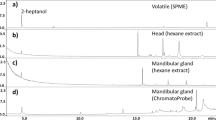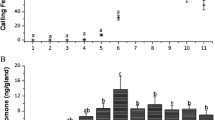Abstract
Enantiomerically pure (S)-(+)-linalool was the main constituent in the extracts of the cephalic secretions of virgin females, mated females, freshly emerged males, and patrolling males of the solitary bee Colletes cunicularius. After copulation, the content of (S)-(+)-linalool emitted by the female was strongly reduced. Electrophysiological experiments revealed that both enantiomers of linalool elicited responses from the antennae of the males. Field tests using the pure enantiomers and the racemate of linalool showed that the number of male bees attracted was highest for (S)-(+)-linalool. The search flight activity in the mating flight area increased dramatically when patrolling males were presented with (S)-(+)-linalool vs (R)-(−)-linalool. Taken together, these data indicate a mate attractant pheromone function of (S)-(+)-linalool.
Similar content being viewed by others
References
Ayasse, M., Paxton, R. P., and Tengö, J. 2001. Mating behavior and chemical communication in the order of Hymenoptera. Annu. Rev. Entomol. 46:31-78.
Baeckstroem, P., Stridh, K., Li, L., and Norin, T. 1987. Claisen rearrangements with mesityl oxide dimethyl ketal. Synthesis of ipsdienone, E-and Z-ocimenone, 2,6-dimethyl-2,7-octadien-4-one and 2,6-dimethyl-2,7-octadien-4-ol. Acta Chem. Scand. Ser. B 41:442-447.
Batra, S. W. T. 1980. Ecology, behavior, pheromones, parasites and management of the sympatric vernal bees Colletes inaequalis, C. thoracicus and C. validus. J. Kans. Entomol. Soc. 53:509-538.
Bergström, G. and Tengö, J. 1978. Linalool in mandibular gland secretion of Colletes bees (Hymenoptera: Apoidea). J. Chem. Ecol. 4:447-449.
Bergström, G., Tengö, J., Reith, W., and Francke, W. 1982. Multicomponent mandibular gland secretions in three species of Andrena bees (Hym., Apoidea). Z. Naturforsch. C: Biosci. 37:1124-1129.
Bjostad, L. B. 1998. Electrophysiological methods, pp. 339-375, in J. G. Millar and K. F. Hayne (Eds.). Methods in Chemical Ecology, Vol. 1. Kluwer Academic Publishers, Boston.
Borg-Karlson, A.-K., Lindström, M., Persson, M., Valterová, I., and Norin, T. 1993. Enantiomeric compositon of monoterpene hydrocarbons in different tissues of Norway spruce Picea abies (L.) Karst. A multidimensional gas chromatography study. Acta Chem. Scand. 47:138-144.
Borg-Karlson, A.-K., Unelius, R. C., Valterová, I., and Nilsson, A. L. 1996. Floral fragrance chemistry in the early flowering shrub Daphne mezereum. Phytochemistry 41:1477-1487.
Cane, J. H. and Tengö, J. 1981. Pheromonal cues direct mate seeking behavior of male Colletes cunicularius (Hymenoptera, Colletidae). J. Chem. Ecol. 7:427-436.
Cornforth, R. H., Cornforth, J. W., and Prelog, V. 1960. über die absolute Konfiguration von Linalool, eine Berichtigung. Liebigs Ann. Chem. 634:197-198.
Francke, W., Lübke, G., Schröder, W., Reckziegel, A., Imperatriz-Fonseca, V., Kleinert, A., Engels, E., Hartfelder, K., Radke, R., and Engles, W. 2000. Identification of oxygen containing volatiles in cephalic secretions of workers of Brazilian stingless bees. J. Braz. Chem. Soc. 11:562-571.
Hefetz, A., Batra, S. W. T., and Blum, M. S. 1979. Linalool, neral and geranial in the mandibular glands of Colletes bees—an aggregation pheromone. Experientia 35:320-321.
Hefetz, A., Taghizadeh, T., and Francke, W. 1996. The exocrinology of the queen bumble bee Bombus terrestris (Hymenoptera: Apidae, Bombini) Z. Naturforsch. 51c:409-422.
Klimetzek, D., Köhler, J., KrohnS., and Francke, W. 1989. Das Pheromonsystem des Waldreben-Borkenkäfers, Xylocleptes bispinus Duft. (Col., Scolytidae). J. Appl. Entomol. 107:304-309.
König, W. A. 1992. Gas chromatographic inantiomer separation with modified cyclodextrine, Hüthig Birch Verlag, Heidelberg, 168 pp.
Larsen, O. N., Gleffe, G., and Tengö, J. 1986. Vibration and sound communication in solitary bees and wasps. Physiol. Entomol. 11:287-296.
Lindsley, E. G. and Zavortnik, T. J. 1977. Attraction of female Colletes louisae bees to netted, conspecific females (Hymenoptera Apoidea). Wasmann J. Biol. 35:144-148.
Manktelow, S. 1991. Pollination biology in Daphne mezereum (Thymelaeaceae), an early-flowering shrub. Master thesis. Uppsala University, 19 pp.
Martin, S. F. and Dodge, J. F. 1991. Efficacious modification of the Mitsunobu reaction for inversions of sterically hindered secondary alcohols. Tetrahedron Lett. 32:3017-3020.
Mori, K. 1998. Semiochemicals-synthesis, stereochemistry, and bioactivity. Eur. J. Org. Chem. 1998:1479-1489.
Rajotte, E. G. and Roberts, R. B. 1980. Mating behaviour of the bees Colletes thoracicus (Hymenoptera: Colletidae), J. N.Y. Entomol. Soc. 88:66-67.
Schurig, V. and Novotny, H.-P: 1990. Gas chromatographic separation of enantiomers on cyclodextrin derivatives. Angew. Chem. Int. Ed. Engl. 29:939-1076.
Tengö, J. 1979. Odour-released behaviour in Andrena male bees (Apoidea, Hymenoptera). Zoon 7:15-48.
Tengö, J. and Bergström, G. 1977. Comparative analyses of complex secretions from heads of Andrena bees (Hym., Apoidea). Comp. Biochem. Physiol. 57B:197-202.
Tengö, J., Eriksson, J., Borg-Karlson, A.-K., Smith, B., and Dobson, H. 1989. Mate-locating strategies and multimodal communication in male mating behaviour of Panurgus banksianus and P. calcaratus (Apoidea, Andrenidae). J. Kans. Entomol. Soc. 61:388-395.
Tollsten, L. and Knudsen, J. T. 1992. Floral scent in dioecious Salix (Salicaceae)—a cue determining the pollination system? Plant Syst. Evol. 182:229-237.
West-Eberhard, M. J. 1984. Sexual selection, competitive communication and species specific signals in insects, pp. 284-324, in T. Lewis (ed). Insect Communication. Academic Press, London.
Author information
Authors and Affiliations
Corresponding author
Rights and permissions
About this article
Cite this article
Borg-Karlson, AK., Tengö, J., Valterová, I. et al. (S)-(+)-Linalool, a Mate Attractant Pheromone Component in the Bee Colletes cunicularius . J Chem Ecol 29, 1–14 (2003). https://doi.org/10.1023/A:1021964210877
Issue Date:
DOI: https://doi.org/10.1023/A:1021964210877




